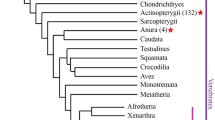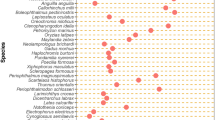Abstract
We have assessed the distribution and diversity of members of the Tc1/mariner superfamily of transposable elements in the channel catfish (Ictalurus punctatus) genome as well as evaluating the extent of transcription of Tc1 transposases in the species. Through use of PCR amplification and sequencing, assessment of random BAC end sequences (BES) equivalent to 1.2% genome coverage, and screening of over 45,000 catfish ESTs, a significant proportion of Tc1-like elements and their associated transcripts were captured. Up to 4.2% of the catfish genome in base pairs appears to be composed of Tc1-like transposon-related sequences and a significant fraction of the catfish cellular mRNA, approximately 0.6%, was transcribed from transposon-related sequences in both sense and antisense orientations. Based on results of repeat-masking, as much as 10% of BAC end sequences from catfish, which is a random survey of the genome, contain some remnant of Tc1 elements, suggesting that these elements are present in the catfish genome as numerous, small remnants of the transposons. Phylogenetic analysis allowed comparison of catfish Tc1 transposase types with those found in other vertebrate and invertebrate species. In spite of the existence of many types of Tc1-like sequences that are not yet able to be placed in clades with strong statistical support, it is clear that multiple families of Tc1-like elements exist in channel catfish.





Similar content being viewed by others
Abbreviations
- BES:
-
BAC end sequences
- Bp:
-
base pair
- dNTP:
-
Deoxynucleotide triphosphate
- E:
-
Expectation value
- EST:
-
Expressed sequence tag
- IR:
-
Inverted repeat
- ORF:
-
Open reading frame
- PCR:
-
Polymerase chain reaction
References
Arca B, Savakis C (2000) Distribution of the transposable element Minos in the genus Drosophila. Genetica 108:263–267
Avancini RM, Walden KK, Robertson HM (1996) The genomes of most animals have multiple members of the Tc1 family of transposable elements. Genetica 98:131–140
Cao D, Kocabas A, Ju Z, Karsi A, Li P, Patterson A, Liu Z (2001) Transcriptome of channel catfish (Ictalurus punctatus): initial analysis of genes and expression profiles of the head kidney. Anim Genet 32:169–188
Castro JP, Carareto CM (2004) Drosophila melanogaster P transposable elements: mechanisms of transposition and regulation. Genetica 121:107–118
Davidson AE, Balciunas D, Mohn D, Shaffer J, Hermanson S, Sivasubbu S, Cliff MP, Hackett PB, Ekker SC (2003) Efficient gene delivery and gene expression in zebrafish using the Sleeping Beauty transposon. Dev Biol 263:191–202
Dawson A, Finnegan DJ (2003) Excision of the Drosophila mariner transposon Mos1. Comparison with bacterial transposition and V(D)J recombination. Mol Cell 11:225–235
Dupuy AJ, Akagi K, Largaespada DA, Copeland NG, Jenkins NA (2005) Mammalian mutagenesis using a highly mobile somatic Sleeping Beauty transposon system. Nature 436:221–226
Fadool JM, Hartl DL, Dowling JE (1998) Transposition of the mariner element from Drosophila mauritiana in zebrafish. Proc Natl Acad Sci USA 95:5182–5186
Finnegan DJ (1989) Eukaryotic transposable elements and genome evolution. Trends Genet 5:103–107
Goodier JL, Davidson WS (1994) Tc1 transposon-like sequences are widely distributed in salmonids. J Mol Biol 241:26–34
Gottgens B, Barton LM, Grafham D, Vaudin M, Green AR (1999) Tdr2, a new zebrafish transposon of the Tc1 family. Gene 239:373–379
Gueiros-Filho FJ, Beverley SM (1997) Trans-kingdom transposition of the Drosophila element mariner within the protozan Leishmania. Science 276:1716–1719
Heierhorst J, Lederis K, Richter D (1992) Presence of a member of the Tc1-like transposon family from nematodes and Drosophila within the vasotocin gene of a primitive vertebrate, the Pacific hagfish Eptatretus stouti. Proc Natl Acad Sci USA 89:6798–802
Henikoff S (1992) Detection of Caenorhabditis transposon homologs in diverse organisms. New Biol 4:382–388
Hoffmann R (2005) Gene expression patterns in human and mouse B cell development. Curr Top Microbiol Immunol 294:19–29
Ivics Z, Izsvak Z (2004) Transposable elements for transgenesis and insertional mutagenesis in vertebrates: a contemporary review of experimental strategies. Methods Mol Biol 260:255–276
Ivics Z, Kaufman CD, Zayed H, Miskey C, Walisko O, Izsvak Z (2004) The Sleeping Beauty transposable element: evolution, regulation and genetic applications. Curr Issues Mol Biol 6:43–55
Ivics Z, Hackett PB, Plasterk RH, Izsvak Z (1997) Molecular reconstruction of Sleeping Beauty, a Tc1-like transposon from fish, and its transposition in human cells. Cell 91:501–510
Ivics Z, Izsvak Z, Minter A, Hackett PB (1996) Identification of functional domains and evolution of Tc1-like transposable elements. Proc Natl Acad Sci USA 93:5008–5013
Izsvak Z, Ivics Z, Hackett PB (1995) Characterization of a Tc1-like transposable element in zebrafish (Danio rerio). Mol Gen Genet 247:312–322
Kawakami K, Shima A, Kawakami N (2000) Identification of a functional transposase of the Tol2 element, an Ac-like element from the Japanese medaka fish, and its transposition in the zebrafish germ lineage. Proc Natl Acad Sci USA 97:11403–11408
Kim S, Karsi A, Dunham RA, Liu Z (2000) The skeletal muscle alpha-actin gene of channel catfish (Ictalurus punctatus) and its association with piscine specific SINE elements. Gene 252:173–181
Knox DP, Skuce PJ (2005) SAGE and the quantitative analysis of gene expression in parasites. Trends Parasitol 21:322–326
Kocabas A, Li P, Cao D, Karsi A, He C, Patterson A, Ju Z, Dunham R, Liu ZJ (2002) Expression profile of the channel catfish spleen: analysis of genes involved in immune functions. Mar Biotechnol 4:526–536
Koga A, Hori H (2000) Detection of de novo insertion of the medaka fish transposable element Tol2. Genetics 156:1243–1247
Koga A, Hori H (2001) The Tol2 transposable element of the medaka fish: an active DNA-based element naturally occurring in a vertebrate genome. Genes Genet Syst 76:1–8
Krasnov A, Koskinen H, Afanasyev S, Molsa H (2005) Transcribed Tc1-like transposons in salmonid fish. BMC Genomics 6:107
Kumar S, Tamura K, Nei M (2004) MEGA3: integrated software for molecular evolutionary genetics analysis and sequence alignment. Brief Bioinfor 5:150–163
Lam WL, Seo P, Robison K, Virk S, Gilbert W (1996) Discovery of amphibian Tc1-like transposon families. J Mol Biol 257:359–366
Leaver MJ (2001) A family of Tc1-like transposons from the genomes of fishes and frogs: evidence for horizontal transmission. Gene 271:203–214
Liu ZJ, Nichols A, Li P, Dunham RA (1998a) Inheritance and usefulness of AFLP markers in channel catfish (Ictalurus punctatus), blue catfish (I. furcatus) and their F1, F2 and backcross hybrids. Mol Gen Genet 258:260–268
Liu ZJ, Karsi A, Li P, Cao D, Dunham R (2003) An AFLP-based genetic linkage map of channel catfish (Ictalurus punctatus) constructed by using an interspecific hybrid resource family. Genetics 165:687–694
Liu ZJ, Li P, Dunham RA (1998b) Characterization of an A/T-rich family of sequences from channel catfish (Ictalurus punctatus). Mol Mar Biol Biotechnol 7:232–239
Liu ZJ, Li P, Kucuktas H, Dunham RA (1999) Characterization of nonautonomous Tc1-like transposable elements of channel catfish (Ictalurus punctatus). Fish Physiol Biochem 21:65–72
Loukeris TG, Livadaras I, Arca B, Zabalou S, Savakis C (1995) Gene transfer into the medfly, Ceratitis capitata, with a Drosophila hydei transposable element. Science 270:2002–2005
Melamed P, Chong KL, Johansen MV (2004) Evidence for lateral gene transfer from salmonids to two Schistosome species. Nat Genet 36:786–787
Miskey C, Izsvak Z, Kawakami K, Ivics Z (2005) DNA transposons in vertebrate functional genomics. Cell Mol Life Sci 62:629–641
Miskey C, Izsvak Z, Plasterk RH, Ivics Z (2003) The Frog Prince: a reconstructed transposon from Rana pipiens with high transpositional activity in vertebrate cells. Nucleic Acids Res 31:6873–6881
Peale FV Jr, Gerritsen ME (2001) Gene profiling techniques and their application in angiogenesis and vascular development. J Pathol 195:7–19
Plasterk RH (1996) The Tc1/mariner transposon family. Curr Top Microbiol Immunol 204:125–143
Quiniou SM, Wolters WR, Waldbieser GC (2005) Localization of Xba repetitive elements to channel catfish (Ictalurus punctatus) centromeres via fluorescence in situ hybridization. Anim Genet 36:353–354
Radice AD, Bugaj B, Fitch DH, Emmons SW (1994) Widespread occurrence of the Tc1 transposon family: Tc1-like transposons from teleost fish. Mol Gen Genet 244:606–612
Saitou N, Nei M (1987) The neighbor-joining method: a new method for reconstructing phylogenetic trees. Mol Biol Evol 4:406–425
Sambrook J, Frisch EF, Maniatis T (1989) Molecular Cloning, A Laboratory Manual. Cold Spring Harbor Laboratory Press, Cold Spring Harbor
Sinzelle L, Pollet N, Bigot Y, Mazabraud A (2005) Characterization of multiple lineages of Tc1-like elements within the genome of the amphibian Xenopus tropicalis. Gene 349:187–196
Sinzelle L, Chesneau A, Bigot Y, Mazabraud A, Pollet N (2006) The mariner transposons belonging to the irritans subfamily were maintained in chordate genomes by vertical transmission. J Mol Evol 62:53–65
Thompson JD, Higgins DG, Gibson TJ (1994) ClustalW: improving the sensitivity of progressive multiple sequence alignment through sequence weighting, position-specific gap penalties and weight matrix choice. Nucleic Acids Res 22:4673–4680
Turcotte K, Bureau T (2002) Phylogenetic analysis reveals stowaway-like elements may represent a fourth family of the IS630-Tc1-mariner superfamily. Genome 45:82–90
Wadman SA, Clark KJ, Hackett PB (2005) Fishing for answers with transposons. Mar Biotechnol 7:135–141
Xu P, Wang S, Liu L, Peatman E, Somridhivej B, Thimmapuram J, Gong G, Liu Z (2006) Channel catfish BAC-end sequences for marker development and assessment of syntenic conservation with other fish species. Anim Genet 37:321–326
Acknowledgements
This project was supported by National Research Initiative Grant No. # 2006-35616-16685 from the USDA Cooperative State Research, Education, and Extension Service under the Animal Genome Basic Genome Reagents and Tools Program, and in part by a Specific Cooperative Agreement with USDA ARS Aquatic Animal Health Laboratory under the Contract Number 58-6420-5-030. Samiran Nandi was supported by a fellowship from the Department of Biotechnology of the Government of India.
Author information
Authors and Affiliations
Corresponding author
Rights and permissions
About this article
Cite this article
Nandi, S., Peatman, E., Xu, P. et al. Repeat structure of the catfish genome: a genomic and transcriptomic assessment of Tc1-like transposon elements in channel catfish (Ictalurus punctatus) . Genetica 131, 81–90 (2007). https://doi.org/10.1007/s10709-006-9115-4
Received:
Accepted:
Published:
Issue Date:
DOI: https://doi.org/10.1007/s10709-006-9115-4




